People love cichlids. And a tremendous varietca comes from the African Rift Lakes – also known as the African Great Lakes.
An inland version of a coral reef, you’ll find cichlids in every color and pattern within the lakes. And the frontosa (Cyphotilapia frontosa) is the perfect example.
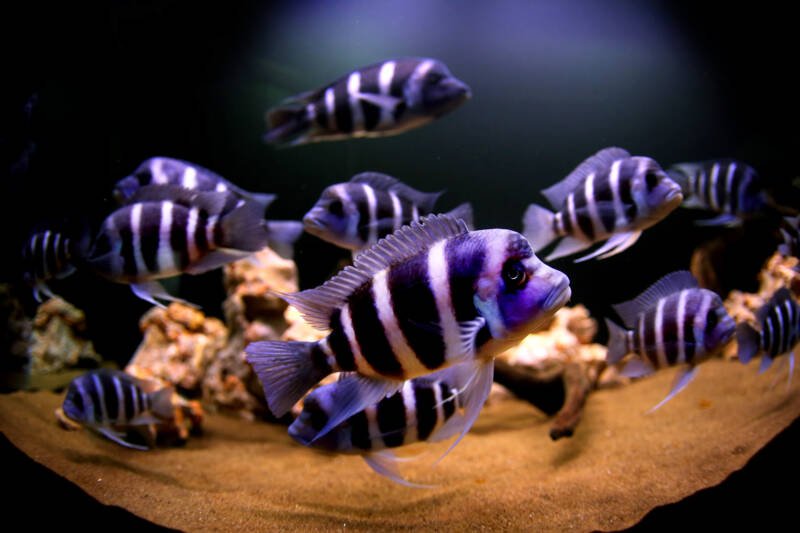
Frontosa cichlids sit atop the pinnacle of the fishy food chain in the Rift Lakes. Their large size and hunting habits make them a fearsome predator to many of the smaller cichlid species.
And their bold blue stripes single them out for aquarists hunting for new acquisitions.
The large cichlids congregate in schools – one of the few cichlids you can keep together without a problem. And they display a characteristic nuchal hump on their foreheads. Combine all of their traits, and you end up with a fish that’s difficult to resist.
They come with a few challenges, though – and that impressive size is only the start.
So before you bring home your striped shoal, make sure you have some experience under your belt. As personable as frontosas are, they’re also demanding.
At a Glance
| Tank Size: | 75 gallons (284 l) – for ONE |
| School Size: | 8-12, ideally |
| Temperature: | 72-86°F (22-30°C) |
| Lifespan: | 15-20 years |
| Size: | 8-15 inches (20-38 cm) |
| pH: | 8.0-9.0 |
| Hardness: | 10-20 dH |
| Ammonia: | 0 ppm |
| Nitrite: | 0 ppm |
| Nitrate: | <20 ppm |
In this article
In the Wild
Frontosa cichlids make their home in the world’s longest (second LARGEST) freshwater lake: Lake Tanganyika.
Stretching over 12,700 square miles (20,438.7 square km), Lake Tanganyika touches Burundi, the Democratic Republic of Congo, Tanzania, and Zambia.
Tanganyika is also the second oldest lake, coming in at over EIGHT MILLION YEARS OLD. (It’s second to Lake Baikal in Siberia)
No wonder it houses the most diverse collection of cichlid species in the world! You’ll find over 250 unique species – including the frontosa.
The lake ranks as the second deepest, too. The depth and age of the water provide an ecosystem with niches for every kind of fish. You’ll see smaller species that zoom around after plankton, all the way to the predators lurking in the depths that hunt THEM.
Frontosa cichlids swim in large shoals at depths of 35-170 feet (10 – 50 m), if not deeper.
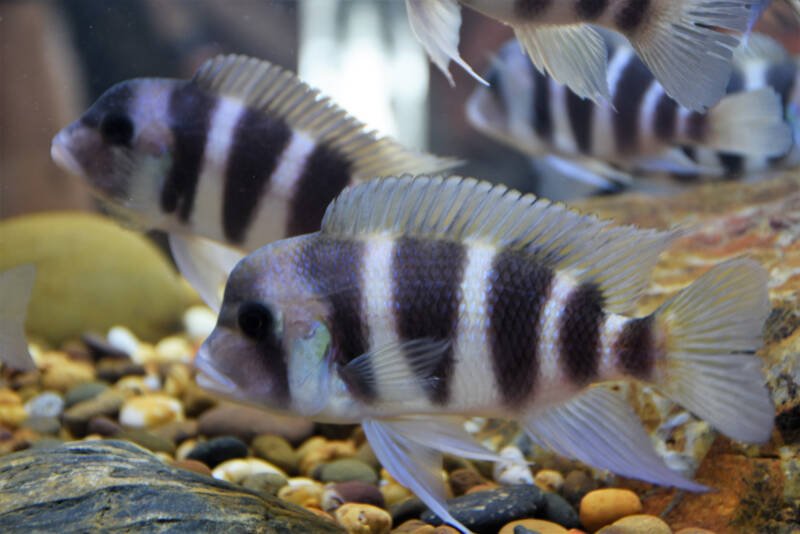
This provides a clear vantage point for them to hunt smaller cichlids close to the surface. As a result, you can find schools of up to ONE THOUSAND fish swimming together.
People import frontosas under the name of the region of the lake in which they’re caught. This is why you’ll see them listed under such names as:
- Bulu Point
- Burundi
- Chaitika
- Ikola
- Kapampa
- Kavala
- Kigoma
- Kipili
- Moba
- Mpimbwe.
The Kigoma is one of the most sought-after of the varieties. Rather than six vertical bars, they have seven.
Meanwhile, the most popular – and bluest – of the frontosa cichlids is the Blue Zaire or Moba. This is a different species of frontosa, Cyphotilapia gibberosa.
Frontosa cichlids contain plenty of information in their scientific names – including their shape.
Cypho comes from a Greek word, referring to a curve. Tilapia is African for fish. And then you have frontosa which means “large forehead.”
As the fish mature, the males (in particular) develop a prominent nuchal hump on the front of their heads.

This is what they’re both known for, in addition to their stripes. You’ll also see them referred to as humphead cichlids as a result.
Size: Dinner or Dinner Plate?
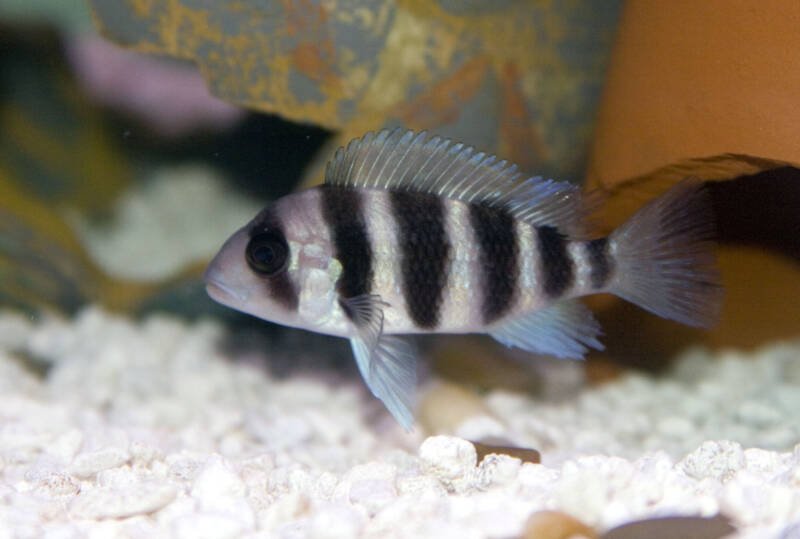
Frontosas display sexual dimorphism. The females are much smaller than the males, coming in at around 8-10 inches (20-25 cm) at their adult size. In contrast, males can grow as long as 15 inches (38 cm) at full size.
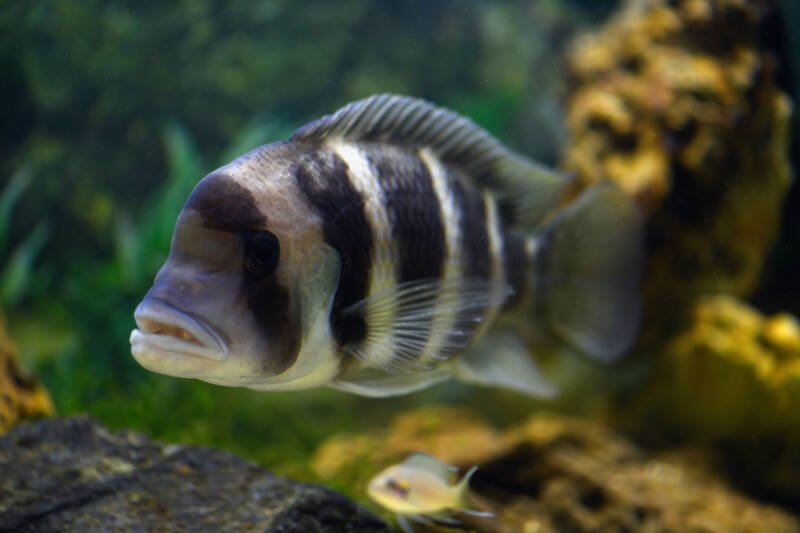
And while these predators find themselves one of the dominant cichlids in Lake Tanganyika, they also end up on the menu. They’re considered quite the delicacy in the countries that border the lake.
Lifespan
If you plan to take on the moderate challenge presented by the frontosa cichlid, you need to prepare yourself for a commitment. They often live between 15-20 years in captivity.
And a few have survived as long as TWENTY-FIVE years with proper care!
Behavior
Despite their position in the predator ranks, frontosa cichlids aren’t as aggressive as other members of their family.
Outside of the breeding season, they’re pretty peaceful when provided with the proper swimming space.
And while you CAN get away with keeping frontosas on their own, they do better in schools.
The species lives in enormous shoals in the wild, and they prefer to adopt the same behavior in a freshwater tank. A group of up to 8-12 fish will keep them calm and active.
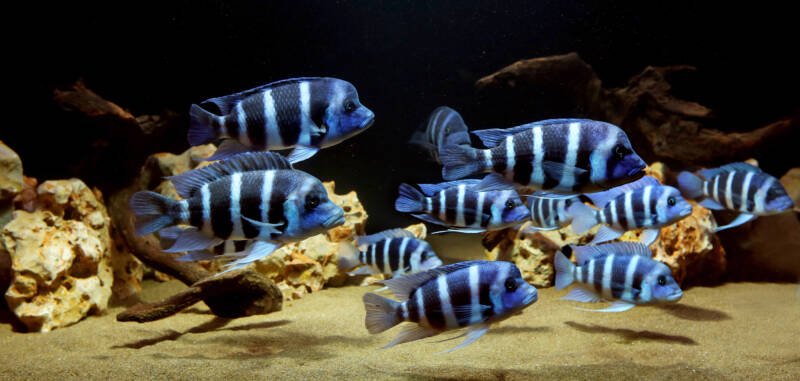
If you’re hoping to minimize potential bursts of aggression, set up a harem with a single male. The smallest school would need three females.
You’ll still see displays of bullying if other fish encroach on their territory, but you won’t have to cope with fighting.
However, even in an appropriately sized school, don’t expect an active aquarium.
Frontosas aren’t energetic fish. As ambush predators, they remain still the majority of the time. When they DO decide to swim, it’s a slow process – and often clumsy to witness.
Tank Setup
Frontosas are prize fish when it comes to size. And you’ll need to keep that in mind when you consider your aquarium setup.
For one frontosa, you’ll need 75 gallons (284 l), at least. Anything smaller will end up on the narrow side and restrict the cichlid’s movements.
If you go with a small harem, you need to upgrade to 150 gallons (568 l). And, of course, larger schools will require even more space.
But when you see all of those bright blue and black stripes moving through the water, it’ll be worth it.
You WILL need a high-powered canister filter sized for your tank. As carnivores, frontosas produce TONS of waste.
And they’re not tolerant of declining water quality. So while you may choose to add plants to the aquarium, you’ll need something with more power.
The oxygen levels in Lake Tanganyika are HIGH. And frontosas demand the same levels. Plants alone won’t do the trick, so you’ll need several air stones. Keep them constantly running to provide proper oxygen at all times.
Finally, don’t run out and splurge on dramatic, powerful lighting.
While most aquarists love frontosas for their bold blue coloring, these cichlids hang out in the deeper regions of the lake. When exposed to bright light, they become stressed and retreat into hiding. Keep things dim.
Water Conditions
The impressive age of all of the Rift Lakes has allowed the waters to stabilize. As a result, you don’t see variations in their water conditions.
The same needs to hold for your aquarium. If you have a wild-caught frontosa, a sudden change could lead to the death of your fish.
Falling along the tropical belt of the African continent, Lake Tanganyika’s waters are warm. So you’ll want to mimic those temperatures of 72-86°F (22-30°C). And since there’s no seasonal variation in the region, you’ll want to keep the temp stable.
The Rift Lakes are alkaline and contain HARD water.
You can go as high as 9.0 on pH range, but don’t go any lower than 7.0 (the sweet spot is 8.0-8.5). Your hardness level should stay between 10-20 dH. You can find a Tanganyika blend of salt to help.
While captive-bred frontosas are hardier than their wild cousins, you still want to keep things as pristine as possible.
Unfortunately, they’re not the easiest cichlids to manage. With ZERO tolerance for ammonia and nitrites, you’ll need to perform 10-20% water changes every week.
Decorating the Frontosa Cichlid Tank
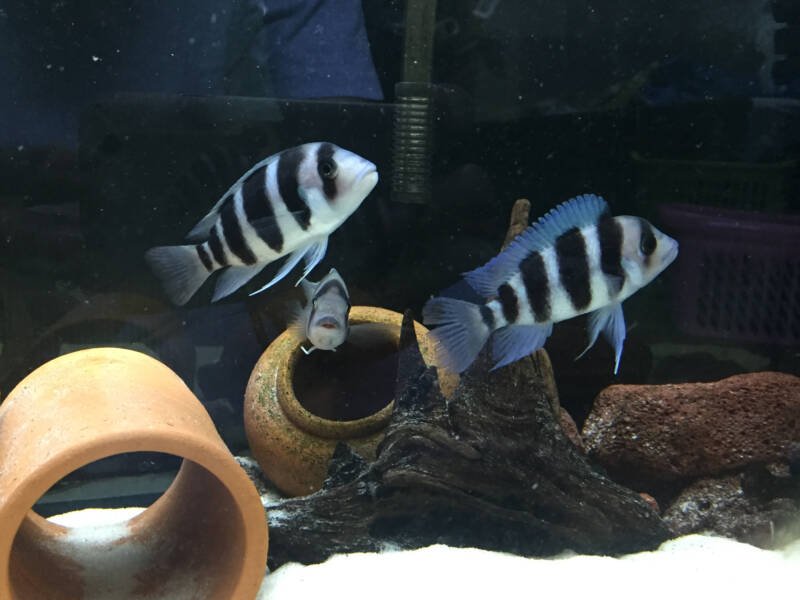
True to cichlid behavior, frontosa cichlids like to redecorate. Therefore, no matter how you choose to set up their tank, they’re going to redesign things THEIR way. As such, you’ll want to select décor that can survive fish landscaping habits.
Many aquarists may struggle to meet that alkaline pH demand. Going with aragonite sand or crushed coral substrate can help.
The white shade will help those blue and black stripes stand out nicely, as a bonus to the buffering effect. You can also get away with smaller-grained gravels.
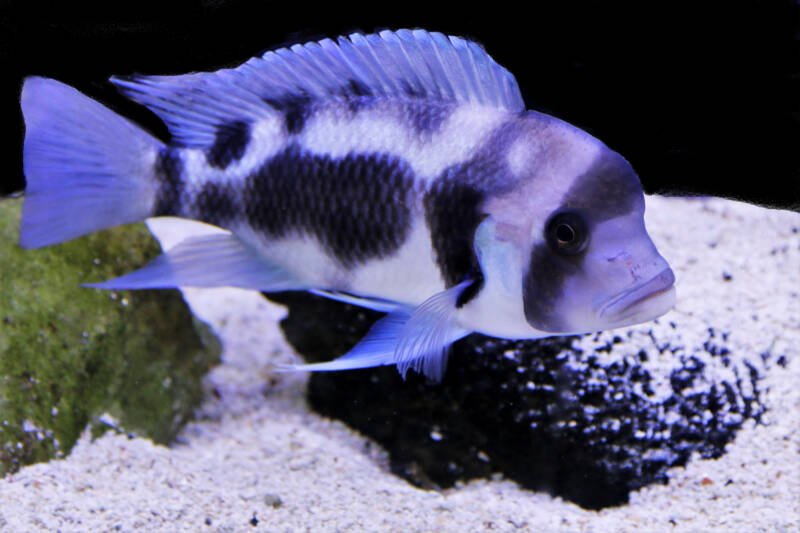
Plants help increase the dissolved oxygen in the water. But they’re going to end up torn away from the sand.
And you need species that handle hard water, a high pH, AND low light levels. That limits your choices:
- Anubias
- Java fern.
You may want to go with plastic plants, instead. They’ll hold up better. And you can still create a beautiful landscape with caves and rocky overhangs.
In addition, the décor will help dim the light further and give your frontosas somewhere to hide out.
Frontosa Cichlids in Communities
While frontosas ARE predators, they’re not as aggressive as other cichlids you’ll find. As long as other fish stay out of their territory in an aquarium, they remain peaceful.
Of course, you need to take care during the breeding season, but they DO work in communities.
Tank Mates
If you can find fish with a tolerance for the hard, alkaline waters that frontosas prefer, you can create a stunning community tank.
And while that may seem impossible, remember those 250 other Rift Lake cichlids. You have PLENTY to choose from – including all frontosa varieties.
You’ll also find a few other hardy species that can tolerate the water conditions without a problem.
And while it’s tempting to mix frontosas with Central or South American cichlids, skip it. The two don’t share immune system compatibility. Stick to these other options:
- Cuckoo catfish
- Rainbowfish
- Rift Lake cichlids.
Incompatible Species
When pairing up frontosa cichlids and other colorful freshwater fish, the biggest concern is making sure they can’t fit in your striped hunter’s mouth.
Avoid any fish under three inches in length. That’s the perfect snacking size. Even fast swimmers may end up on the menu.
You also want to avoid larger fish with aggressive streaks. Frontosas may be predators, but they’re not bullies like some of their cousins.
Faced with a bigger, meaner fish, they’ll retreat into hiding. Try to avoid all of these as tank mates:
- Barbs
- Central American cichlids
- Gouramis
- Livebearers
- Silver dollars
- South American cichlids
- Tetras.
Food and Diet
Frontosa cichlids are carnivores. And their favorite meal in the world? Cyprichromis spp. cichlids.
In the wild, they drift under Cyprichromis schools at dawn and dusk, waiting to snatch the smaller fish unawares. (And they’ll happily swallow one up if you pair the two together)
You can, of course, provide fish (alive or dead) to your frontosas. But feeder fish aren’t the healthiest and won’t offer top nutrition. Also, with the risk of parasites and bacterial infection, you only want to use feeders as a last resort.
Instead, choose protein sources you can offer with feeding tongs. (Remember, these aren’t fast-swimming fish. They can’t compete at the surface for food)
You’ll boost the color of their scales and provide the proper nutrients. Your frontosas will happily accept any of the following:
- Cockle
- Krill
- Mussel
- Mysis shrimp
- Prawns.
Of course, you still need to add in the occasional veggie component. Even carnivores need some greens now and then.
And frontosa cichlids don’t mind spinach or kale they can nibble at. Or you can check for those ingredients on sinking cichlid pellets.
Breeding Frontosa Cichlids: Forming a Harem
Frontosa cichlids are one of the mouth-brooding species. It makes them fun to watch when you decide to breed them.
And as long as you’ve created a suitable environment, they’re not difficult to pair and raise.
Male or Female?
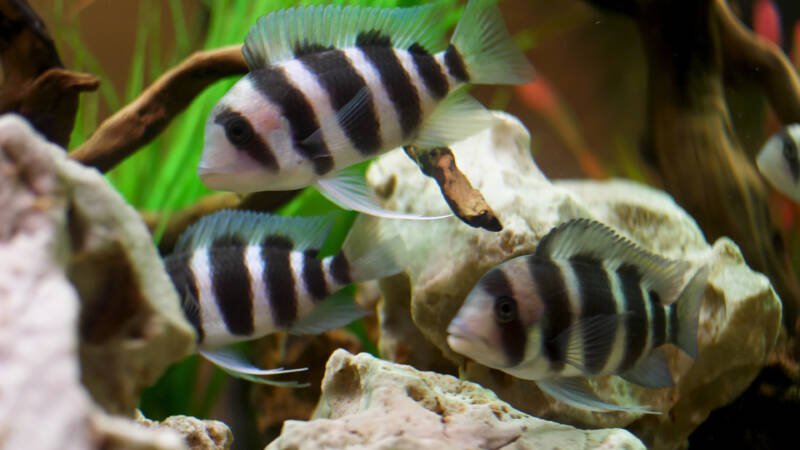
Until frontosas reach sexual maturity (around three years), you’re not going to tell the two sexes apart. They look identical. It’s only after that age that the nuchal hump on the males – and extensions of their fins – develop.
If you know you’re interested in breeding frontosa cichlids, set up a tank with at least 10-12 fish to start. You’ll then have a chance to sort out the males from the females as they age.
Once you have a proper harem (only one male), you’ll be ready to get spawning underway.
Mouth-Brooding at Its Finest
You can set up a separate breeding tank, but frontosas do fine in an aquarium with pristine water conditions and a healthy supply of high-quality food.
And that food’s the best way to prep them to spawn. You’ll trigger the production of eggs and sperm with whole proteins.
It’s essential to offer the female as much live food as possible before spawning.
Once she lays her eggs, she’ll stop eating for ONE MONTH. If she doesn’t have sufficient fat stores built up, she could up suffering health problems.
Frontosas don’t require elaborate breeding sites. Just offer them caves or similar structures. The male will select one and begin to defend the area.
Then the blue coloration around the nuchal hump will deepen in color, attracting the female’s attention.
Once satisfied, the pair will clean their designated space. The male circles around before releasing a small amount of milt. This triggers the female to lay an egg. She then backs up and picks it up in her mouth.
The pair repeats the process until she lays all of her eggs (anywhere from 20-50).
She then incubates the eggs in her mouth for 5-7 weeks. When the fry hatch, she releases them to feed in a “cloud” around her head.
The male will stand guard while the fry eat. And they’re BIG baby fish – around 0.5 inch (1.3 cm).
They don’t need infusoria; they’ll eat brine shrimp nauplii or powdered flake foods. If either parent senses danger, they signal, and the fry dash back into the female’s mouth.
You’ll see this behavior continue for 40-50 days. At that point, the fry are large and strong enough to venture out on their own. You can then shift them to a separate tank. Or you can leave them in the community tank.
Hardiness and Diseases
While hardy, frontosa cichlids often develop problems with ich. And that applies to wild-caught AND captive-bred fish.
It’s easy enough to cure the pest with copper, but keeping up with weekly water changes to prevent the problem will do more for you.
You can also find yourself struggling with other common ailments if you fail to keep your tank clean. In addition, offering fish store feeder fish may lead to further complications, such as:
- Bacterial infections
- Fungal infections
- Parasites.
Frontosa Cichlids: Are They For You?
You’ll find frontosa cichlids in most fish stores for anywhere between $30-$50 a fish. It’s a steep price – especially as you should maintain a school.
The unique combination of their blue and black stripes and the personable habits of these fish drive the cost up.
However, they often form attachments to their owners. Some people even find them behaving almost dog-like once they’ve settled in. (Not unlike the Oscar or Jack Dempsey) And many aquarists feel the cost is worth that kind of bond.
Personable Monsters of the Rift Lakes
Frontosa cichlids have a fearsome reputation – if you ask smaller cichlids in the Rift Lakes. But among aquarists, those striking blue stripes and calm demeanors are worth the trouble of their management needs.
Do you keep frontosas? Which of the regional varieties is your particular favorite?
Have you witnessed the mouth-brooding first-hand?
Let us know your stories and questions here!